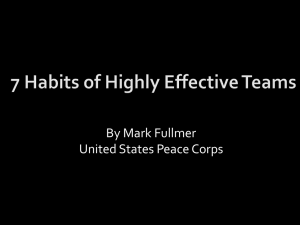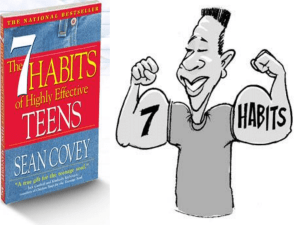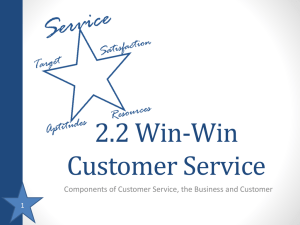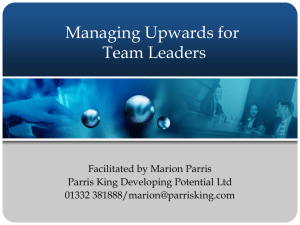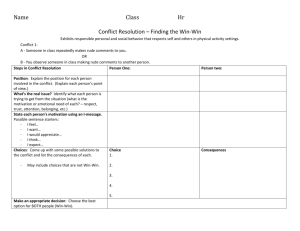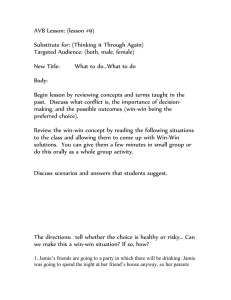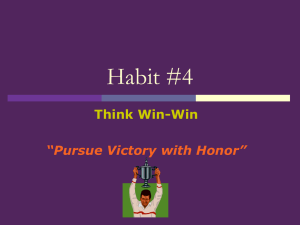BEYOND WIN-WIN IN THE SUPPLY CHAIN
advertisement
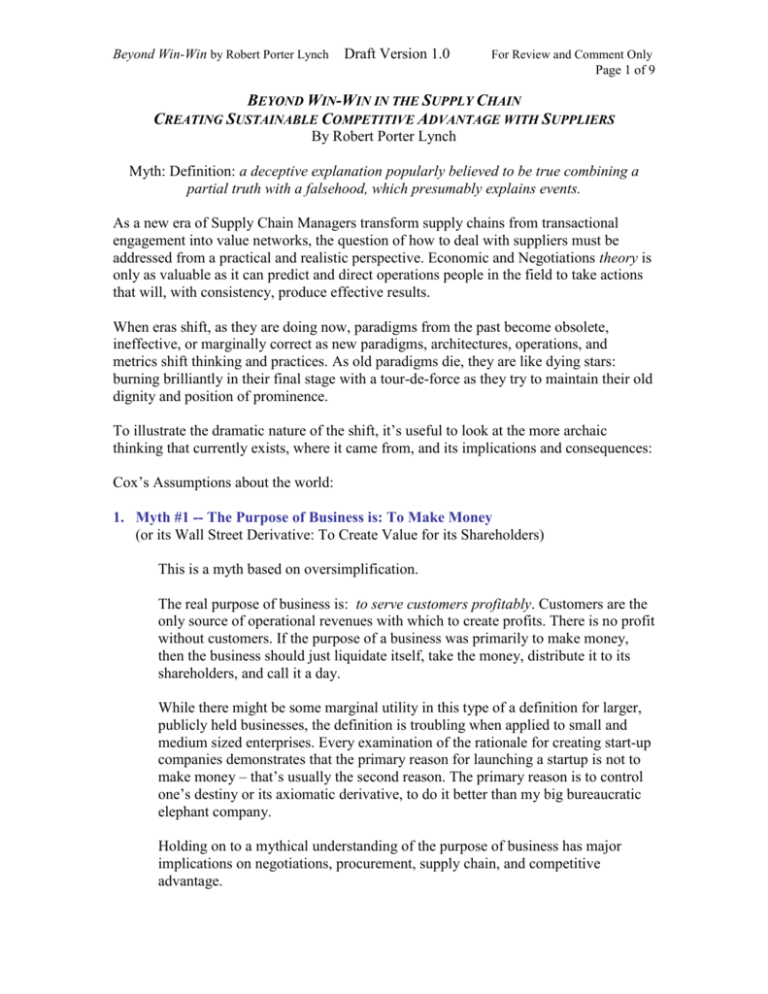
Beyond Win-Win by Robert Porter Lynch Draft Version 1.0 For Review and Comment Only Page 1 of 9 BEYOND WIN-WIN IN THE SUPPLY CHAIN CREATING SUSTAINABLE COMPETITIVE ADVANTAGE WITH SUPPLIERS By Robert Porter Lynch Myth: Definition: a deceptive explanation popularly believed to be true combining a partial truth with a falsehood, which presumably explains events. As a new era of Supply Chain Managers transform supply chains from transactional engagement into value networks, the question of how to deal with suppliers must be addressed from a practical and realistic perspective. Economic and Negotiations theory is only as valuable as it can predict and direct operations people in the field to take actions that will, with consistency, produce effective results. When eras shift, as they are doing now, paradigms from the past become obsolete, ineffective, or marginally correct as new paradigms, architectures, operations, and metrics shift thinking and practices. As old paradigms die, they are like dying stars: burning brilliantly in their final stage with a tour-de-force as they try to maintain their old dignity and position of prominence. To illustrate the dramatic nature of the shift, it’s useful to look at the more archaic thinking that currently exists, where it came from, and its implications and consequences: Cox’s Assumptions about the world: 1. Myth #1 -- The Purpose of Business is: To Make Money (or its Wall Street Derivative: To Create Value for its Shareholders) This is a myth based on oversimplification. The real purpose of business is: to serve customers profitably. Customers are the only source of operational revenues with which to create profits. There is no profit without customers. If the purpose of a business was primarily to make money, then the business should just liquidate itself, take the money, distribute it to its shareholders, and call it a day. While there might be some marginal utility in this type of a definition for larger, publicly held businesses, the definition is troubling when applied to small and medium sized enterprises. Every examination of the rationale for creating start-up companies demonstrates that the primary reason for launching a startup is not to make money – that’s usually the second reason. The primary reason is to control one’s destiny or its axiomatic derivative, to do it better than my big bureaucratic elephant company. Holding on to a mythical understanding of the purpose of business has major implications on negotiations, procurement, supply chain, and competitive advantage. Beyond Win-Win by Robert Porter Lynch Draft Version 1.0 For Review and Comment Only Page 2 of 9 If two negotiators are trying to transact business between each other, it’s in each business’ interests/purpose to make a profit, regardless of the definition. A winlose strategy for negotiations means one of the parties will be faced with not operating in its best interests. Most companies will not put up with this option for long, if at all. If they work outside of their purpose/interest, they will ultimately be faced with bankruptcy. Therefore, they will, somewhere in the transaction, either get even, get out, or both. For example, as a consequence of facing its suppliers with draconian negotiations tactics, General Motors, which often accounted for 25-50% of its supplier’s volume, drove many of its suppliers into situations where it had to sell to GM at a loss. When confronted with this reality, they had a ready made tactic for getting even: make back the losses on GM’s change orders. Some chose consolidation with the hope of reducing operational overhead, with little success. The bankruptcies of Dana Corp. and Delphi are just a few examples of the fallacy of this approach. At the small and medium enterprise (SME) level, the opportunity for avoiding win-lose negotiations may be deeper. Many owners simply opted out of the GM supply chain, choosing the relatively more friendly Honda or Toyota buyers. Still others chose to get out of the industry totally or partially. 2. Myth #2 – Because Buyer and Seller have differing assessments in how value is gauged in the transaction, in practice they have objectively conflictual interests. This myth is a myth because it is a part truth and a part misconception. What is truthful is that two parties engaging in a transaction have differing value gauges to determine whether it is in their best interests to engage in a “deal.” The parts of this myth that are either: obsolete, secondary, or misconceived are important to the understanding the fundamental nature of supply chains. First, procurement is only a small component of how supply chains create value. A supply chain is fundamentally engaged in transformation of labor, materials, and technology into products and services that are of more value to a customer than a competitors products and services. Therefore, the procurement, dealmaking, and bargaining processes must be viewed not in isolation, but how they affect the transformation processes into strategic competitive advantage. The critical element here is therefore not just price/cost, but how well the parties regard each other as a team to produce customer value. The key components of this transformation are the ability to create strategic and operational synergies, specifically: The ability to coordinate work together, hence trust each other The ability to co-create together, hence innovate together The ability to align together, hence synchronize their operations together Beyond Win-Win by Robert Porter Lynch Draft Version 1.0 For Review and Comment Only Page 3 of 9 The ability to adapt to changes in the strategic environment, hence reposition together Second, as the world has accelerated its clock speed, having to produce more and more with less and less and in far less time, the differentials of interests between buyer and seller have to be sublimated by necessity to the realities of speed, innovation, and integration. There is simply no room for bickering and dickering, which leads to excessive non-value added costs, dysfunctional behavior, and wasted time which all translates into potentially devastating impacts on competitiveness. In addition, in a world of high complexity of technologies, unnecessary switching costs can produce lag times that are competitively crippling. For example, a decade ago, when GM wanted to introduce its new model of Sunbird and Cavalier at their Lordstown plant, the two models comprised a significant portion of GM’s market share. Driving too hard a bargain with their suppliers in the false assumption that their suppliers were making inordinately large profits, GM squeezed their suppliers mercilessly for cost cuts. They received the cost advantages, on the surface. However, quality control and parts integration suffered horribly, resulting in an 18 month delay in new product introduction. Customers went to show-rooms and found no cars available. They bought Toyotas and Hondas instead. What GM had hoped for in cost savings of about $2 billion, instead resulted in a loss of about $8 billion in revenue, making the cost savings a Pyrrhic victory. Today these two models are marginal entries in their class. Third, Relationships are a very important component of the value analysis in any buyer-seller interaction. If the buyer and seller are to engage in a one time interaction, what they think of each other may not matter for much. But this changes entirely if the buyer and seller are to interact over a period of years or generations. Memories are long lived. If a seller gets a raw deal, is not paid the proper amounts, is abused, is treated as a lowly “vendor,” is the recipient of the worst end of a one-sided contract, is forced to stretch receivables interminably, then this will have a major impact not only on the next round of negotiations, but also on whether there are any negotiations at all, what the price will be to compensate for the abuse, and who gets the next round of new innovations. For example, a well conceived and positive relationship with a supplier of Intuit’s produced a virtually exclusive flow of all the new innovations from the supplier. Similarly, Honda and Toyota receive their suppliers innovation streams from their supplier, with whom they have the most positive relationship; while GM and Ford get the short end of the stick based on a poor relationship with suppliers. Procter & Gamble’s supplier relationship program has paid of handsomely with innovation streams from suppliers, which translates directly into bottom line profits. 3. Myth #3 – Power is the primary basis for relative strength of the buyer-supplier relationship. Beyond Win-Win by Robert Porter Lynch Draft Version 1.0 For Review and Comment Only Page 4 of 9 Again, like all myths there is an element to truth to this, but that small truth should not be extrapolated into a universal truth. Here’s is what’s true: In some markets, some buyers and some sellers are dominant, to the point of having a monopoly. Consider Microsoft in software, Wal-Mart in retailing, or many airlines in their hub where they have a dominant position and therefore presumably control pricing with near monopolistic behavior. Or AT&T before the breakup. In these cases, the dominant player may control. What happens in markets there either buyer or seller are dominant, a monopoly occurs. Monopolies are inherently dysfunctional because innovation is stifled. Eventually other forces will destroy a monopoly, just as the railroad and steel monopolies were destroyed. The issue of “who has the power” is also based on a very narrow definition of how power is used in any relationship whether it be inter-personal, interorganizational, or inter-national. Power can be used in three fundamentally different ways: DOMINANCE: POSITIONING Forces AGAINST to OVERWHELM an opponent an opponent in a Win-Lose Game BALANCE: EQUALIZING Forces in a series of TRADE-OFFS and COMPROMISES to achieve an Quasi-Win-Win ALIGNMENT: COORDINATING Forces with a strategic ally to create a SYNERGISTIC, SYNCHRONISTIC, and SYSTEMATIC Win-Win Power Dominance probably prevails in 20 percent or so of the cases. In the other 80 percent of the situations, Power Balance or Power Alignment are far better options, and the effective negotiator will be adept in their use. 4. Myth #4 – In a world of Scarcity, Win-Lose negotiations is the best approach As one authority of the old paradigm recently stated: “Your purpose in a world of economic scarcity is not to be nice – it’s all about win-lose. Win-Win is B---S---.” This idea is both dangerous and impractical. In a world of Scarcity, win-lose can only be used in a short-term, one-time play. Two examples will illustrate: Labor Management Negotiations: This is a buyer (management) and seller (labor) relationship. Using win-lose approaches, which is the norm for many such negotiations, usually results in a lose-lose. General Motors has always lost in a strike, as have their UAW counterparts. GM’s Japanese counterparts engage in win-win, and strikes don’t happen. When win-lose begins, trust is broken. In environments of low trust, many grievances are Beyond Win-Win by Robert Porter Lynch Draft Version 1.0 For Review and Comment Only Page 5 of 9 filed. The total cost of ownership of a single grievance is between $1020,000. Win-Lose usually produces losses for everyone but the lawyers in a long-term relationship because the loser will always try to get even in the next round. Commercial Airplanes: Airlines must replenish and modernize their fleets. In the large aircraft world, there are essentially only two competitors left – Boeing & Airbus -- now that Lockheed has opted out of the business and McDonnell-Douglas has merged with Boeing. Win-Lose negotiations on the part of buyers drove supplier consolidation. Should one or the other drop out of the market for lack of profits, the industry will be left with having to buy from a monopolistic supplier, who could and probably would raise prices to make a fine return on investment. A win-win approach would have been better from the start. However, win-win is not just a matter of price. Innovation is a critical component of any supply chain. Win-Lose shifts the focus of the paradigm into negotiations and deal making instead of strategy and value creation. While win-lose negotiations may have value in a world of commodity procurement where there is an infinite number of suppliers, it has no practical value in a world where these conditions exist: too few suppliers most suppliers making marginal profits supplier is strategic to your value creation possibility of killing the supply base innovation is critical to competitive advantage In most supply chains today, innovation is a critical element of competitive advantage. Win-lose negotiations will never create continuous streams of innovation. To the contrary, win-lose will stifle all innovation. Consequently, win-lose, as a practical matter, has no business in most businesses. The issue of win-lose is tied directly to the presumption that we live in a world of scarcity, and there is only so much to go around. This is the basis of the “haves and have nots” approach to economics. Ever since Malthus’ dismal pessimism proved mathematically (based on the geometric growth of population and the arithmetic growth of food suppliers) that the world could not produce enough food to support its population growth "The power of population is so superior to the power of the earth to produce subsistence for man, that premature death must in some shape or other visit the human race. Sickly seasons, epidemics, pestilence, and plague, advance in terrific array … gigantic inevitable famine stalks in the rear, and with one mighty blow levels the population…of the world." Beyond Win-Win by Robert Porter Lynch Draft Version 1.0 For Review and Comment Only Page 6 of 9 The Malthusian fallacy is the failure to either acknowledge or stimulate human capacity to innovate by increases production methods in the food supply chain. Similarly, innovation becomes the antidote for scarcity in many (but not all) situations. The reasons for this are based on the existence of not just one, but two economic systems working in parallel and simultaneously. The first economic system is classical economics, run by the laws of supply and demand in the environment of scarcity. For example, oil and gas are becoming scarce commodities priced according to supply and demand. As demand increases, supply diminishes, and price increases. As price continues to escalate, new innovations will come into play which either increase supply or create alternative fuels. In the world of scarcity, most players will chose to horde their resources. The Economics of Scarcity could also be called the Economics of Expendables. The second economic system is virtual economics, run by the laws of synergy and creativity in an environment of abundance. For example, software is one of the most cheaply reproduced products in the world. Most of it can be transmitted on the internet for virtually nothing. Then, once it is installed on a computer, the more it is used, the more valuable it becomes. Using more of it does not create less of it; to the contrary it produces more of it. When it’s replaced, its substitute is presumably better, faster, more reliable, easier to use. It is seldom replaced by something of just equal capacity or functionality. Therefore, the traditional economic laws of supply, demand, and price do not prevail in the economics of abundance. Other examples proliferate. Creativity also exists in the world of abundance. When a person, team, or business partners engage creatively to invent a new product, process, technology, or idea, their creative “juices” are not used up when they are put into play. Quite to the contrary, their creativity expands based on their trust of each other and their willingness to share resources. The Economics of Abundance might be termed the Economics of Expandables. In the world of Supply Chain Management, it is crucial to understand how to negotiate a win-win so as not to create adverse reactions in the world where scarcity prevails and, just as importantly, to know how to stimulate a parallel flow of innovation in the world of abundance. Beyond Win-Win by Robert Porter Lynch Draft Version 1.0 For Review and Comment Only Page 7 of 9 5. Myth #5 – Win-Win is too fuzzy, it’s basically anything you are happy with. Understanding the dynamics of win-win is to be able to understand the metrics of winning, from three perspectives: the user, the buyer, and the seller, and be sure all three are in alignment. By alignment, this means not the same, but parallel, compatible, symbiotic. If the metrics of winning are misaligned, some one of the three will lose, making the value proposition insufficient or unappealing. Procter & Gamble aligns its supply chain to two moments of truth: When the customer buys the product, and when the customer uses the product. Should either of these critical value propositions be unsatisfying, the customer will not return, P&G will not receive long term revenue, and the supplier will lose accordingly. Supplier’s measure of a win must be linked intimately to the customer’s. Every customer is potentially a long-term relationship with the provider. Excellence in win-win negotiations is first based on knowing the “elements of victory” for each party, and then being committed to manifesting the idea of a win-win. Elements of Victory: The most effective means of engaging in a win-win is to be clear, from both party’s perspectives, what measurable results will represent a “win.” This should be clear to each party. When negotiating the elements of victory, it’s usually effective to understand that it is nearly always more than just money that the other party desires. In fact, if it is only money that’s considered valuable, then the relationship is probably neither strategic nor innovative, and therefore is merely a tactical, making win-win a minor issue. The multi-dimensional analysis for measuring the win are: Market Impact Competitive Advantage Innovative Capacity Performance Effectiveness Financial Return To keep the elements of victory in long-term alignment, a clear customerfocused value proposition should be the ultimate, over-riding aim of the relationship. Commitment to Win-Win: A effective win-win is not a chance occurrence, but the result of a carefully architected process. Because win-win may require a delicate alignment of forces which can be destabilized by people who do not understand the nature of the relationship, the best win-win arrangements are managed by people who make it their business to be committed to the win-win. The level of commitment can be arrayed on a spectrum: Beyond Win-Win by Robert Porter Lynch Draft Version 1.0 For Review and Comment Only Page 8 of 9 STRONG MEDIOCRE WEAK We will stand together, committed to our mutual winning to achieve a common goal, and defend the other in the face of adversity from within because we have established firm Rules of Engagement which I will not let my own side violate – I am committed to retaining our trust. I am committed to you winning as long as you are committed to me winning, I will let you win because I know win-win is good for our long term relationship We must both be willing to strike compromises and make concessions if we are to achieve win-win I must protect my interests, and, inasmuch as they are protected, you can take what is left or what is in your interests I will fight to win, and you must fight to win, and somewhere in the middle we will strike a balance I expect you to fight for your ground, & I will fight for mine, & whatever ground I let you take is yours As an additional observation: A win-win is only possible if both parties believe a win-win is not only possible but essential to the future of the relationship. Should one party not believe in a synergistic mutual future, it is highly unlikely it will or could occur. 6. Myth #6 – It’s not in the interests of Buyer & Seller to Maximize their benefit This is true only in the following limited circumstances The Relationship is: o Tactical o Transactional o of limited duration Distrust is so prevalent and irretrievable that the only protection in the engagement is a strong legal contract Innovation, Process Improvements, and Integration are not valued in the transaction Where these conditions prevail, there is little value in trying to create synergies that will forever remain illusive and idealistic. However, in a fast-moving, rapidly changing world, where innovation, speed, and integration must manifest and suppliers are strategic to the buyer, it is not only in each party’s interests, it is imperative to maximize benefit simply to maintain competitive advantage as conditions change rapidly. For example, one of the primary reasons General Motors and Ford have lost significant market share is because the competitors have created a powerful, aligned, and synergistic value network that produces innovations faster, better, and cheaper than the combative relationships at GM and Ford. Beyond Win-Win by Robert Porter Lynch Draft Version 1.0 For Review and Comment Only Page 9 of 9 7. Myth #7 – Exchange is at the heart of all human existence The veracity of this statement depends solely upon what paradigm one stands in. - TRANSACTIONS are the centerpiece of the exchange-based procurement world. - TRANSFORMATIONS are the centerpiece of the fast-time, integrated, innovation-based supply chain world. A transaction-based world is a small micro-economic world looking at the exchange of relative value, usually translating the value into monetary terms. If I am buying apples at the local supermarket, I exchange my money for the market’s fruit. A transformation-based world is larger and spans time. If I am buying food for the supermarket, I want to know not just the price today, but what I might expect in terms of logistics, temperature control during shipping, organic growing methods, inventory control to prevent spoilage, new packaging innovations, shelf life expectation, returns policy, information technology integration, etc. etc. How the product is transformed from the ground to the hands of the buyer is important, not just the exchange of money for goods.
